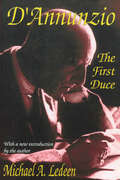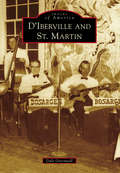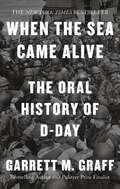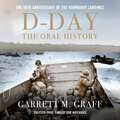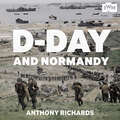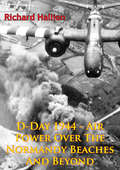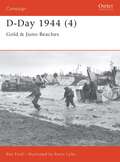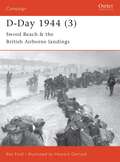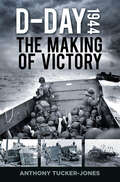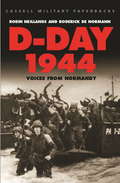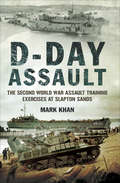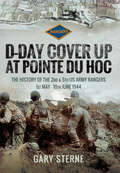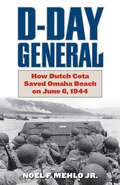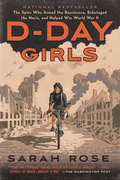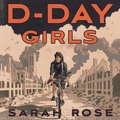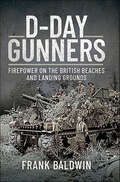- Table View
- List View
D'Annunzio: The First Duce
by Michael LedeenGabriele D'Annunzio was one of the most flamboyant figures in the political history of modern Europe. A poet in the Byronic style and a popular hero of the First World War, D'Annunzio passionately believed that the sacrifices of war should prelude a new social order. His capture of the city of Fiume in 1919, which had been claimed by Italy as part of the settlement before the Versailles Peace Conference, has been popularized and romanticized ever since. Ledeen uses information gathered from Italian and American archives and from personal interviews to examine the sixteen months of D'Annunzio's personal rule in Fiume, seeing it as a harbinger of successful mass movements of the twentieth century. The connection between D'Annunzio and Fascism is central to Ledeen's narrative. Virtually the entire ritual of Fascist politics made familiar by Mussolini-the balcony address, the Roman salute, the dramatic dialogues with the crowd, the use of religious symbols in a new secular setting-was influenced by D'Annunzio at Fiume. Both were masters of a political style based on personal charisma. Each spoke for a "new" Italy and, eventually, for a new world. Each attempted to transform his countrymen into more heroic types by an ethic of violence and grandeur. But Ledeen brings sharply into focus profound differences between D'Annunzio's vision of a new world and that offered by Fascism. Significantly, D'Annunzio enlisted support from the most diverse elements of society-politicians and businessmen in addition to representatives of radical trade unions, anarchist groups, and the armed forces. Often sensationalized as a precursor of a sixties-style "dolce vita," D'Annunzio's Fiume presented many of the phenomena considered novel or unsettling today: sexual promiscuity, widespread experimentation with drugs, clergymen wanting to marry, women demanding equal rights, youth calling for the elimination of the old, soldiers insisting on a democratic army, poets yearning for a beautiful world instead of a purely utilitarian one, minorities clamoring for their fair share of political power. From the dispassionate distance of half a century, Ledeen views Fiume as a microcosm of the larger chaos of our contemporary scene. Although he was removed from Fiume after a pitched battle on land and sea, D'Annunzio remained an influential figure in Italian politics. Ledeen presents him as "one of the great innovators and watersheds of the modern world." This book will be of interest to historians, political scientists, and those interested in Post World War I Italy. An authority on Italian fascism and contemporary Europe, Michael A. Ledeen is Resident Scholar at the American Enterprise Institute in Washington. In addition to being a frequent contributor to The New Republic, The American Spectator, and 11 Giornale (Milan), he is the author of 15 books on contemporary history and politics.
D'Iberville and St. Martin
by Dale GreenwellD'Iberville and the community of St. Martin share more than a common origin: from their colonial beginnings they have been one, now separated only by an invisible county line. The first is named after Pierre LeMoyne, Sieur d'Iberville, commander of the French fleet who initiated settlement of Louis XIV's claim to the Mississippi Valley and adjacent coast of the Mexican Gulf in 1699. The latter is named for Raymond St. Martin de Pattier (or Jorquiboey), who married into the pioneer Ladnier family that homesteaded the north side of Biloxi Bay in the late 1700s and were the first landowners when the colonial era ended and the American flag was hoisted in 1811. After statehood in 1817, foreign and American emigrants arrived by ship and covered wagon. Before the Civil War, the families north of the bay included Spanish, Austrian, Italian, and their "African chattel." From this frontier beginning, farmers and fishermen spawned ranching, timber, and seafood industries as well as shipbuilding and mercantile enterprises. By World War II, it was a town, and in 1988 it became a city within the core of this old frontier.
D-DAY The Oral History: The Turning Point of WWII By the People Who Were There
by Garrett M. GraffA LANDMARK NEW ACCOUNT OF THE SINGLE MOST IMPORTANT DAY OF WW2, IN THE WORDS OF THE PEOPLE WHO LIVED IT'A sprawling history of D-Day from the point of view of participants on both sides.' -Kirkus'A masterpiece of oral history. Stirring, surprising, grim, joyous, moving and always riveting.' -Evan ThomasOn 6th June 1944, the Allied invasion began. For hours, wave after wave of soldiers, sailors, and airmen crossed the channel and stormed the Normandy coast, fighting to gain a foothold in Nazi-occupied Northwest Europe. It was the largest combined air and seaborne invasion ever, involving over 150,000 Allied troops on the ground, and its eventual success became a critical turning point in the war, spelling the beginning of the end for the Third Reich.As the events of that day fade from living memory, it's more important than ever to understand what it felt like to be there and to live through it, on both sides. In this definitive work, Garrett M. Graff, the bestselling author of The Only Plane in the Sky: The Oral History of 9/11, compiles over 600 US, Canadian, UK, French and German voices to tell the full story of exactly how that historic day unfolded, in visceral detail - as well as the weeks and months leading up to it. From paratroopers to fighter pilots to nurses, generals, French villagers, German Defenders to Winston Churchill and Franklin Roosevelt, this is the most intimate re-telling of D-Day published to date. Praise for THE ONLY PLANE IN THE SKY: "The most moving and chilling oral history you will read." The Times"Incredibly evocative and compelling." The Washington Post"A hugely powerful new book." Dan Snow"Astonishing book about an astonishing, terrifying atrocity, relived in real time by those who were there. I read it in one sitting & was utterly gripped from start to finish." Piers Morgan
D-DAY The Oral History: The Turning Point of WWII By the People Who Were There
by Garrett M. GraffA LANDMARK NEW ACCOUNT OF THE SINGLE MOST IMPORTANT DAY OF WW2, IN THE WORDS OF THE PEOPLE WHO LIVED IT'A sprawling history of D-Day from the point of view of participants on both sides.' -Kirkus'A masterpiece of oral history. Stirring, surprising, grim, joyous, moving and always riveting.' -Evan ThomasOn 6th June 1944, the Allied invasion began. For hours, wave after wave of soldiers, sailors, and airmen crossed the channel and stormed the Normandy coast, fighting to gain a foothold in Nazi-occupied Northwest Europe. It was the largest combined air and seaborne invasion ever, involving over 150,000 Allied troops on the ground, and its eventual success became a critical turning point in the war, spelling the beginning of the end for the Third Reich.As the events of that day fade from living memory, it's more important than ever to understand what it felt like to be there and to live through it, on both sides. In this definitive work, Garrett M. Graff, the bestselling author of The Only Plane in the Sky: The Oral History of 9/11, compiles over 600 US, Canadian, UK, French and German voices to tell the full story of exactly how that historic day unfolded, in visceral detail - as well as the weeks and months leading up to it. From paratroopers to fighter pilots to nurses, generals, French villagers, German Defenders to Winston Churchill and Franklin Roosevelt, this is the most intimate re-telling of D-Day published to date. Praise for THE ONLY PLANE IN THE SKY: "The most moving and chilling oral history you will read." The Times"Incredibly evocative and compelling." The Washington Post"A hugely powerful new book." Dan Snow"Astonishing book about an astonishing, terrifying atrocity, relived in real time by those who were there. I read it in one sitting & was utterly gripped from start to finish." Piers Morgan
D-Day & Normandy
by Anthony RichardsIn the hours before dawn on June 6, 1944, an unprecedented assemblage of men, weapons, and machines swung into action. The long-awaited, highly secret D-Day invasion had begun. By the end of the day, the mission to liberate Europe would have made its most crucial advance.This book marks the seventy-fifth anniversary of D-Day through a rich account of the invasion and its aftermath. Drawing on the unparalleled collections of IWM, it reconstructs the historic landings and the subsequent battle for a foothold in Normandy. Interviews and firsthand accounts put the reader right into the action, reminding us that even with all the careful planning and firepower the Allies were able to muster, the outcome of the invasion was far from certain. Re-creating the drama and danger of D-Day, this book will be the perfect commemoration of a day that truly changed the world.(P)2020 Headline Publishing Group Limited
D-Day (Cornerstones of Freedom, 2nd Series)
by Tom McgowenThe island of Britain is separated from continental Europe by a stretch of sea known as the English Channel. As night closed over Britain on June 5,1944, the roar of airplane engines filled the air. From 190 airfields on the island, bombers, fighter planes, troop transport planes, and were taking off by the thousands to fly across the Channel. The first blow of the greatest invasion in the history of the world was about to be struck!
D-Day 1944 - Air Power Over The Normandy Beaches And Beyond [Illustrated Edition]
by Richard P. HallionIncludes over 12 photos and maps of the Overlord OperationsOperation Overlord, the Normandy invasion-like William the Conqueror's before it or the Inchon landing afterwards-will long be studied as a classic in military planning, logistics, and operations. OVERLORD depended to a remarkable degree upon the use of air power in virtually all its forms. A half-century ago, aircraft were primitive vehicles of war compared to the modern attackers of the Gulf War era, with their precision weapons, advanced navigational, sensor systems, and communications. Yet, the airplane still had a profound impact upon the success of the invasion. Simply stated, without air power, Normandy would have been impossible.
D-Day 1944: Gold and Juno Beaches
by Ken Ford Kevin LylesOperation Overlord, the Allied invasion of Normandy, was the greatest sea-borne military operation in history. At the heart of the invasion and key to its success were the landings of British 50th Division on Gold Beach and Canadian 3rd Division on Juno Beach. Not only did they provide the vital link between the landings of British 3rd Division on Sword Beach and the Americans to the west on Omaha, they would be crucial to the securing of the beachhead and the drive inland to Bayeux and Caen. In the fourth D-Day volume Ken Ford details the assault that began the liberation of Nazi-occupied Europe.
D-Day 1944: Sword Beach and the British Airborne Landings
by Howard Gerrard Ken FordAt 0016hrs on 6 June 1944 a Horsa glider ground to a halt a mere 60 yards from the Orne Canal bridge at Bénouville in Normandy. A small group of British paratroopers burst from it and stormed the bridge within minutes. The Allied liberation of Nazi-occupied Europe had begun. Within a few hours landing craft would swarm towards Ouistreham as British 3rd Division stormed ashore at Sword Beach. The battle would then begin to break through to relieve the paratroopers. In the third of the D-Day volumes Ken Ford details the assault by British 6th Airborne Division and the British landings on Sword Beach that secured the vital left flank of the invasion.From the Trade Paperback edition.
D-Day 1944: The Making of Victory
by Anthony Tucker-JonesD-Day was unprecedented. An invasion of this scale and magnitude had never been carried out before. The landings in North Africa, Sicily and Italy were of limited scope by comparison; if they had failed it would not have been a complete disaster, whereas Normandy heralded the long-awaited Second Front.D-Day 1944: The Making of Victory investigates the great feats of unique problem-solving that enabled the success of such an important invasion. Military historian Anthony Tucker-Jones brings his expert eye to bear on the D-Day landings and subsequent Normandy campaign. He reassesses the technical ingenuity required through the eyes of those who fought there, and vividly reveals how each side managed, whether dealing with the challenges of crossing the Channel safely or in defence of the French coast. Including first-hand accounts, this book places the reader in the thick of the action.
D-Day 1944: Utah Beach & the US Airborne Landings
by Steven Zaloga Howard GerrardThe second title in Osprey's survey of the D-Day landings of World War II (1939-1945). On their western flank, the Allied landings on D-Day combined a parachute drop by the 82nd and 101st Airborne Divisions with an amphibious assault on "Utah" Beach by the US 4th Infantry Division. The landings came ashore in the wrong place but met weaker German resistance as a result. The heaviest fighting took place inland where the badly scattered paratroopers gradually gathered in small groups and made for their objectives. This book traces the story of D-Day on Utah beach, revealing how the infantry pushed inland and linked up with the Airborne troops in a beachhead five miles deep. Now the battle to break out and seize the key port of Cherbourg could begin.
D-Day 1944: Voices from Normandy
by Robin Neillands Roderick De NormannThe story of D-Day, told in the words of those who were actually there.'The gigantic scale of the invasion is stunningly evoked' - MAIL ON SUNDAYAt fifteen minutes after midnight on June 6 1944, Operation 'Overlord', the Allied invasion of Hitler's Fortress Europe, became reality. In this penetrating account of D-Day and the period which followed, Robin Neillands and Roderick de Normann weave objective narration with personal accounts from those who were there to create a matchless history of the largest amphibious assault ever launched.
D-Day 1944: Voices from Normandy
by Robin Neillands Roderick De NormannThe story of D-Day, told in the words of those who were actually there.'The gigantic scale of the invasion is stunningly evoked' - MAIL ON SUNDAYAt fifteen minutes after midnight on June 6 1944, Operation 'Overlord', the Allied invasion of Hitler's Fortress Europe, became reality. In this penetrating account of D-Day and the period which followed, Robin Neillands and Roderick de Normann weave objective narration with personal accounts from those who were there to create a matchless history of the largest amphibious assault ever launched.
D-Day Assault: The Second World War Assault Training Exercises at Slapton Sands
by Mark Khan&“This superb account describes the exercises undertaken on Slapton Sands, backed up by first hand accounts from those who were there at the time.&” —Military Machines International Preceded by a massive airborne assault, the largest amphibious operation ever undertaken began on June 6, 1944—D-Day. Over a fifty-mile stretch of heavily fortified French coastline, 160,000 Allied troops came ashore on the beaches of Normandy. Supported by more than 5,000 ships and 13,000 aircraft, they quickly gained a foothold in fortress Europe. To plan and execute such a massive military operation successfully required training—and beaches. The perfect place for the Americans was found in the sleepy South Hams area of South Devon. But this choice came at a price. Over 20,000 acres of prime agricultural land, along with villages and farms were requisitioned. The peace of the South Devon coast was soon shattered as the Slapton Sands Assault Training Centre came into being. The training, however, was not without risk. During one of the final major coordinated practices—Exercise Tiger—over 800 men were lost to enemy action whilst traveling by sea to land on the beaches at Slapton Sands. Often shrouded in intrigue, this disaster has been the subject of conspiracy theories for many years. &“Using the latest information available about this secretive event, [D-Day Assault] features all aspects of the military exercises and first hand accounts of those who lived and trained there.&” —Western Morning News
D-Day Bombers (Stackpole Military History Series)
by Stephen Darlow Shanda BrownEyewitness accounts of heavy bombers on D-Day Rarely told story of what happened above the beaches Detailed descriptions of various bombing runs In this vivid and dramatic look at World War II in the air, eight different aircrews--three American and five British--tell eye-opening and heart-racing stories of operations before, during, and after D-Day. These bombing missions helped pave the way for the success of the Allies' invasion of Normandy, disrupting German transportation, destroying various installations, and spreading fear and panic.
D-Day Cover Up at Pointe du Hoc: The History of the 2nd & 5th US Army Rangers, 1st May–10th June 1944
by Gary SterneA follow-up to the New York Times-bestselling The Cover-Up at Omaha Beach. &“The second volume of the epic study breaks new ground.&” —Firetrench Gary Sterne, a keen collector of militaria and co-founder of The Armourer and Skirmish magazines, has always been fascinated by the D-Day landings. In particular he was intrigued by the lack of precise information relating to the mystery of the &“missing guns&” of Pointe du Hoc. His research led to the finding of a map which indicated the position of an &“unknown&” German gun position buried in the village of Maisy. The rediscovery of the Maisy Batteries made headline news around the world and his bestselling book The Cover-Up at Omaha Beach subsequently changed the history of the Omaha sector and made many start to question the Rangers&’ Pointe du Hoc mission. The Maisy site is now one of the major Normandy D-Day attractions. For the first time ever this follow-up book now offers complete Rangers history for the seven months prior to D-Day and does so using period documents, many of which have only recently been released from TOP SECRET status in U.S. Archives. The author fills in the gaps that many have only guessed at concerning the Rangers&’ real missions on D-Day, he explains why a battalion commander was removed hours before the landings, why the Rangers were not briefed on their actual D-Day missions and the extraordinary role that Lt. Col. Rudder played at Pointe du Hoc. This book is a historical game-changer that pulls no punches.
D-Day Encyclopedia: Everything You Want to Know About the Normandy Invasion (World War II Collection)
by Barrett TillmanThis unique encyclopedia provides detailed entries for everything you ever wanted to know about D-Day, the invasion of Normandy. Organized alphabetically, the entries give detailed descriptions of weapons, equipment, divisions, air and naval units, geography, terminology, personalities, and more. Every Allied division that crossed the English Channel on June 6, 1944 has its own listing as do the major Axis divisions that fought them. <P><P>Brief biographies of major military and political leaders on both sides provide a handy who's who of the campaign. The book also includes entries for related popular culture: GI slang, the best movies about D-Day, and major writers such as Stephen Ambrose and Cornelius Ryan. Cross-references make the book easy to use. With hundreds of entries, The D-Day Encyclopedia is an indispensable reference tool for history buffs and great browsing for readers who want to know more about World War II.
D-Day Fortifications in Normandy
by Hugh Johnson Steven ZalogaGerman defenses along the Normandy beaches were part of the larger Atlantic Wall fortifications designed to defend Fortress Europe. When Field Marshal Erwin Rommel took command of the invasion front in late 1943, he began a program to enhance fortifications along the Normandy coast as he believed that any Allied assault had to be stopped on the invasion beaches themselves. His most important contribution to the defenses was an extensive program of improvised beach obstructions to complicate any landing attempt. This book analyses these fortifications and describes how the Allied forces overcame them on the morning of June 6, 1944.
D-Day General: How Dutch Cota Saved Omaha Beach on June 6, 1944
by Noel F. Mehlo Jr.Omaha was the make-or-break Allied beach on D-Day—in (perhaps) the make-or-break campaign of World War II. If American soldiers couldn&’t gain a foothold there, then D-Day was unlikely to succeed. On June 6, 1944, U.S. troops on Omaha suffered the worst casualties of any of the five Allied invasion beaches—so many casualties, and so much tactical difficulty, that Omaha almost didn&’t succeed. One big reason why Americans gained a foothold on Omaha was Gen. Norman &“Dutch&” Cota. A graduate of the West Point class of 1917 (alongside famous classmates Matthew Ridgway, Mark Clark, and Lightning Joe Collins), Norm Cota played football with Dwight Eisenhower, who graduated two years earlier. From March 1941 to February 1943, Cota served with the famous 1st Infantry Division, the Big Red One, as division intelligence officer, plans/training officer, and finally chief of staff. He performed so well in the North Africa campaign that he was sent to England to help plan D-Day. After laying the tactical groundwork for the amphibious landings, Cota was made assistant division commander of the 29th Infantry Division. On the eve of D-Day, he told his men, &“You&’re going to find confusion. The landing craft aren&’t going in on schedule, and people are going to be landed in the wrong place. Some won&’t be landed at all. . . . We must improvise, carry on, not lose our heads.&”On June 6, 1944, under heavy fire, Cota landed with the second wave of the 29th Infantry Division on Omaha Beach, about an hour after the start of the invasion. He personally rallied the survivors of the landings and led the opening of one of the first exits off Omaha. Cota seemed to be everywhere that day. Coming upon a group of Rangers, the general told them, &“Rangers, lead the way&” (hence the Rangers&’ motto). He is also known for saying, &“Gentlemen, we are being killed on the beaches. Let us go inland and be killed.&” And, to a captain uncertain how to proceed: &“I&’ll tell you what, captain.You and your men start shooting at them. I&’ll take a squad of men, and you and your men watch carefully. I&’ll show you how to take a house with Germans in it.&” Having demonstrated the task, Cota asked the officer, &“Do you understand? Do you know how to do it now? . . . I won&’t be around to do it for you again. I can&’t do it for everybody.&”Great quips—which American military history will always remember and which show the character, in every sense, of Dutch Cota. Cota was a fighter—a fighting general, a D-Day general—and his contribution to D-Day will remain his rallying of demoralized troops and his blazing the trail toward the breakout and victory on Omaha. Ted Roosevelt Jr., who landed at Utah Beach, has always received credit as the D-Day general (like Cota, Roosevelt also demanded that he land on D-Day—and then died of a heart attack a month later), but Cota is the hero-general of the day, having landed early on D-Day on bloody Omaha. Portrayed by Robert Mitchum in the grand D-Day film The Longest Day, Cota has not yet received his due—and there&’s a campaign now afoot to award him a belated Medal of Honor. His story cries out to be told. Now, with the cooperation of the Cota family, Noel F. Mehlo Jr. tells the compelling story Dutch Cota on Omaha Beach, revealing new information and never-before-seen photos.
D-Day Girls: The Spies Who Armed the Resistance, Sabotaged the Nazis, and Helped Win World War II
by Sarah RoseThe dramatic, untold true story of the extraordinary women recruited by Britain’s elite spy agency to help pave the way for Allied victory in World War II“ <P><P>In 1942, the Allies were losing, Germany seemed unstoppable, and every able man in England was on the front lines. To “set Europe ablaze,” in the words of Winston Churchill, the Special Operations Executive (SOE) was forced to do something unprecedented: recruit women as spies. Thirty-nine answered the call, leaving their lives and families to become saboteurs in France. <P><P>In D-Day Girls, Sarah Rose draws on recently declassified files, diaries, and oral histories to tell the thrilling story of three of these remarkable women. <P><P>There’s Andrée Borrel, a scrappy and streetwise Parisian who blew up power lines with the Gestapo hot on her heels; Odette Sansom, an unhappily married suburban mother who saw the SOE as her ticket out of domestic life and into a meaningful adventure; and Lise de Baissac, a fiercely independent member of French colonial high society and the SOE’s unflappable “queen.” <P><P>Together, they destroyed train lines, ambushed Nazis, plotted prison breaks, and gathered crucial intelligence—laying the groundwork for the D-Day invasion that proved to be the turning point in the war. <P><P>Rigorously researched and written with razor-sharp wit, D-Day Girls is an inspiring story for our own moment of resistance: a reminder of what courage—and the energy of politically animated women—can accomplish when the stakes seem incalculably high.
D-Day Girls: The Spies Who Armed the Resistance, Sabotaged the Nazis, and Helped Win the Second World War
by Sarah RoseThe dramatic, untold story of the extraordinary women recruited by Britain's elite spy agency to help pave the way for Allied victory, for fans of A WOMAN OF NO IMPORTANCE by Sonia Purnell'Gripping: Spies, romance, Gestapo thugs, blown-up trains, courage, and treachery (lots of treachery) - and all of it true, all precisely documented' ERIK LARSON, author of THE DEVIL IN THE WHITE CITY'The mission is this: Read D-Day Girls today. Not just for the spy flair but also because this history feels more relevant than ever, as an army of women and girls again find themselves in a fight for the common good'LILY KOPPEL, author of THE ASTRONAUT WIVES CLUB 'Thoroughly researched and written as smoothly as a good thriller, this is a mesmerising story of creativity, perseverance, and astonishing heroism' PUBLISHERS WEEKLY, Starred review* * *In 1942, the Allies were losing, Germany seemed unstoppable, and every able man in England was fighting. Believing that Britain was locked in an existential battle, Winston Churchill had already created a secret agency, the Special Operations Executive (SOE), whose spies were trained in everything from demolition to sharpshooting. Their job, he declared, was to 'set Europe ablaze'. But with most men on the front lines, the SOE was forced to do something unprecedented: recruit women. Thirty-nine answered the call, leaving their lives and families to become saboteurs in France. In D-Day Girls, Sarah Rose draws on recently declassified files, diaries, and oral histories to tell the thrilling story of three of these remarkable women. There's Andrée Borrel, a scrappy and streetwise Parisian who blew up power lines with the Gestapo hot on her heels; Odette Sansom, an unhappily married suburban mother who saw the SOE as her ticket out of domestic life and into a meaningful adventure; and Lise de Baissac, a fiercely independent member of French colonial high society and the SOE's unflappable 'queen'. Together, they destroyed train lines, ambushed Nazis, plotted prison breaks, and gathered crucial intelligence-laying the groundwork for the D-Day invasion that proved to be the turning point in the war. Rigorously researched and written with razor-sharp wit, D-Day Girls is an inspiring story for our own moment of resistance: a reminder of what courage-and the energy of politically animated women-can accomplish when the stakes seem incalculably high.
D-Day Girls: The Spies Who Armed the Resistance, Sabotaged the Nazis, and Helped Win the Second World War
by Sarah RoseThe dramatic, untold story of the extraordinary women recruited by Britain's elite spy agency to help pave the way for Allied victory, for fans of A WOMAN OF NO IMPORTANCE by Sonia Purnell'Gripping: Spies, romance, Gestapo thugs, blown-up trains, courage, and treachery (lots of treachery) - and all of it true, all precisely documented' ERIK LARSON, author of THE DEVIL IN THE WHITE CITY'The mission is this: Read D-Day Girls today. Not just for the spy flair but also because this history feels more relevant than ever, as an army of women and girls again find themselves in a fight for the common good'LILY KOPPEL, author of THE ASTRONAUT WIVES CLUB 'Thoroughly researched and written as smoothly as a good thriller, this is a mesmerising story of creativity, perseverance, and astonishing heroism' PUBLISHERS WEEKLY, Starred review* * *In 1942, the Allies were losing, Germany seemed unstoppable, and every able man in England was fighting. Believing that Britain was locked in an existential battle, Winston Churchill had already created a secret agency, the Special Operations Executive (SOE), whose spies were trained in everything from demolition to sharpshooting. Their job, he declared, was to 'set Europe ablaze'. But with most men on the front lines, the SOE was forced to do something unprecedented: recruit women. Thirty-nine answered the call, leaving their lives and families to become saboteurs in France. In D-Day Girls, Sarah Rose draws on recently declassified files, diaries, and oral histories to tell the thrilling story of three of these remarkable women. There's Andrée Borrel, a scrappy and streetwise Parisian who blew up power lines with the Gestapo hot on her heels; Odette Sansom, an unhappily married suburban mother who saw the SOE as her ticket out of domestic life and into a meaningful adventure; and Lise de Baissac, a fiercely independent member of French colonial high society and the SOE's unflappable 'queen'. Together, they destroyed train lines, ambushed Nazis, plotted prison breaks, and gathered crucial intelligence-laying the groundwork for the D-Day invasion that proved to be the turning point in the war. Rigorously researched and written with razor-sharp wit, D-Day Girls is an inspiring story for our own moment of resistance: a reminder of what courage-and the energy of politically animated women-can accomplish when the stakes seem incalculably high.
D-Day Gunners: Firepower on the British Beaches and Landing Grounds
by Frank BaldwinPart history book and part travel guide, D-Day Gunners is aimed at anyone interested in the artillery on the D-Day beaches and landing grounds. While the heritage of the D-Day beaches and landing sites is well documented, this rarely includes the artillery story. The author of this book aims to correct this by providing a visitors' guide to the artillery stories associated with the battlefield heritage that remains on the D-Day beaches, mapping the fire-plan for D-Day against the known German locations, and looking at what happened at these places. There is relatively little explanation about the role of the artillery in general or the deeds of artillerymen, in particular those of the Royal Regiment of Artillery. This book tells of the significance of artillery on D-Day and the part it played in the outcome. Initial reports published stressed that the coastal defences were effectively neutralized by the bombing and that no significant counter attacks developed on D-Day. However, post-war accounts increasingly attributed allied success to allied fire power. The book tells the story of the men who served the guns on the D-Day beaches, and the effects they had on the outcome of the battles on D-Day and afterwards. This volume is primarily about British Gunners and certain German Kannoniers. The book has been written as a guide to the battlefields on the D-Day beaches and landing grounds, telling the gunners’ stories that are not always commemorated on memorials, interpretation boards, or recorded in more general guides. These poignant stories include war poets and heroes decorated for bravery, or just the tales of some of the men buried in the war cemeteries or commemorated on the memorials. It also provides a guide in lay terms of the technical impact of field anti-tank and AA artillery on the war. A second volume will tell the story of artillerymen on the American beaches and landing grounds.
D-Day Illustrated Edition
by Stephen E. AmbroseOn the basis of 1,400 oral histories from the men who were there, bestselling author and World War II historian Stephen E. Ambrose reveals for the first time anywhere that the intricate plan for the invasion of France in June 1944 had to be abandoned before the first shot was fired. The true story of D-Day, as Ambrose relates it, is about the citizen soldiers - junior officers and enlisted men - taking the initiative to act on their own to break through Hitler's Atlantic Wall when they realised that nothing was as they had been told it would be.D-DAY is the brilliant, no holds barred, telling of the battles of Omaha and Utah beaches. Ambrose relives the epic victory of democracy on the most important day of the twentieth century.
D-Day Illustrated Edition: June 6, 1944: The Climactic Battle of World War II
by Stephen E. AmbroseNow illustrated with an extraordinary collection of over 125 photos, Stephen E. Ambrose's D-Day is the definitive history of World War II's most pivotal battle, June 6, 1944, the day that changed the course of history.D-Day is the epic story of men at the most demanding moment of their lives, when the horrors, complexities, and triumphs of life are laid bare. Distinguished historian Stephen E. Ambrose portrays the faces of courage and heroism, fear and determination--what Eisenhower called "the fury of an aroused democracy"--that shaped the victory of the citizen soldiers whom Hitler had disparaged.Drawing on more than 1,400 interviews with American, British, Canadian, French, and German veterans, Ambrose reveals how the original plans for the invasion had to be abandoned, and how enlisted men and junior officers acted on their own initiative when they realized that nothing was as they were told it would be.The action begins at midnight, June 5/6, when the first British and American airborne troops jumped into France. It ends at midnight, June 6/7. Focusing on those pivotal twenty-four hours, the book moves from the level of Supreme Commander to that of a French child, from General Omar Bradley to an American paratrooper, from Field Marshal Montgomery to a German sergeant. Ambrose's D-Day is the most honored account of one of our history's most important days.
